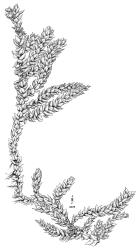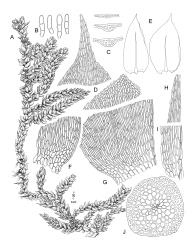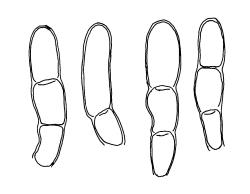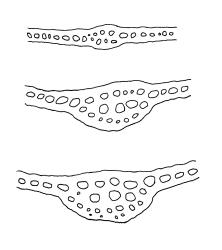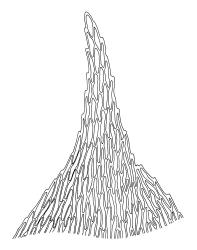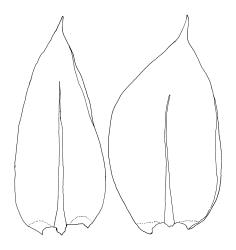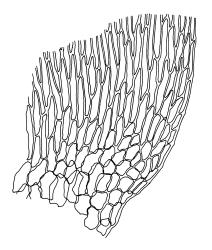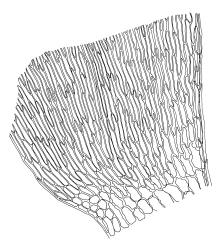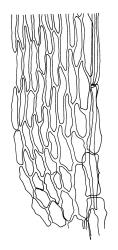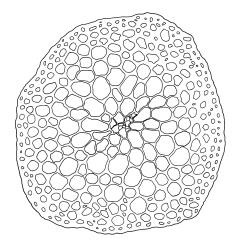- ≡ Hypnum touretii Brid., Muscol. Recent. Suppl. 2, 185 (1812)
- = Scleropodium illecebrum Schimp. in Bruch et al., Bryol. Eur. 6, 29 (1853)
- = Brachythecium cymbifolium Dixon & Sainsbury, J. Bot. 71: 249 (1933)
- = Scleropodium australe Hedenäs, Nova Hedwigia 62: 457–458 (1996)
Plants medium-sized, yellow-green, forming compact mats on insolated soil banks. Stems prostrate, irregularly but much branched, green- or pale brown, to at least 50 mm, strongly curved both wet and dry, in cross-section with a distinct central strand and several layers of thick-walled cortical cells, densely beset below with fascicles of brown, smooth rhizoids. Branches ± uniform in length, mostly 6–10 mm, strongly curved, terete, ± cuspidate at tips. Stem and branch leaves similar, broadly ovate, acute or apiculate and very weakly reflexed at apex, narrowed at insertion, strongly concave, not striolate, slightly spreading when moist, erect and imbricate when dry, with margins erect, weakly and bluntly denticulate (especially at apex) or nearly entire, 1.0–1.6 × 0.6–0.8 mm in N.Z. material. Costa stout but ill-defined, c. 50–60 µm near base, tapered to terminus, rarely weakly spurred, extending c. ¾–⅞ the leaf length, mostly with an inconspicuous abaxial terminal spicule. Upper laminal cells linear-vermicular, rounded at ends, smooth, firm-walled, not porose, 45–60(–75) × 4–5 µm, becoming much shorter at leaf apex; basal cells shorter and broader in several rows, not or moderately porose; alar cells moderately differentiated to form a medium-sized, ± auriculate group, subquadrate to short-rectangular, firm-walled, sometimes with a few larger and inflated cells, extending less than 10 cells up the margin and about halfway to the base of the costa. Axillary hairs difficult to observe, few, 2–4 cells long, lacking pigmented basal cells.
Reportedly dioicous. Perichaetia scattered on stems, c. 1.2 mm, with ecostate, ovate-acuminate leaves. Neither perigonia nor capsules seen in N.Z. material.
Hedenäs 2002, fig. 7 a–c (as S. australe); Smith 2004, fig. 280, 5–8; Seppelt et al. 2011, fig. 1. Smith’s figure shows stem and branch leaves that are more differentiated than seen in N.Z. material.
The strongly curved branches (mostly more curved than shown in Plate 15 ) and more compact and prostrate habit distinguish S. touretii from the much more widespread, loosely interwoven, and ascendant Pseudoscleropodium purum. The stem leaves here are smaller (1.0–1.6 × 0.6–0.8 mm vs c. 1.5–2.1 × 1.0–1.5 mm); the costae are longer (¾–⅞ the leaf length and mostly with an inconspicuous abaxial terminal spicule) relative to the leaf length than those of P. purum (½–⅔ the leaf length, with a terminal spine apparently absent). The leaf apiculi here are very slightly reflexed compared to the often markedly reflexed apiculi of P. purum.
According to Seppelt et al. (2011) and others, Scleropodium touretii has fewer and fewer-celled axillary hairs than P. purum. Axillary hairs, while difficult to demonstrate, are most easily located attached to branch leaf scars following removal of the leaves and staining. In the Wellington Botanical Garden material they conform to Seppelt’s illustration and description.
NI: Hawke’s Bay (Havelock North), Wellington (Wellington Botanical Gardens).
Adventive. Tasmania*. Reported from Britain, Mediterranean and western Europe, western North America, as well as Cyprus, China, Macaronesia, and North Africa by Smith (2004). Lawton (1971) detailed the distribution in western North America; she considered the species to have two varieties there.
This species was first recognised in N.Z. by Peter Beveridge, who collected it in 2008 from an insolated soil bank beside the William Wakefield Way, and at other localities, in the Wellington Botanical Garden.
Beveridge subsequently identified his Wellington Botanical Garden collections using the elegant illustration and detailed discussion by Seppelt et al. (2011) of its Tasmanian occurrence.
An earlier collection by E.A. Hodgson at Havelock North in 1930 was described as Brachythecium cymbifolium Dixon & Sainsbury (1933). It is troublesome that the protologue of this species includes a description of the sporophyte while the type specimen is sterile. Examination of material in Sainsbury’s herbarium shows that the sporophyte description was derived from a fertile topotype (E.A. Hodgson s.n., July 1931, WELT M005753).



